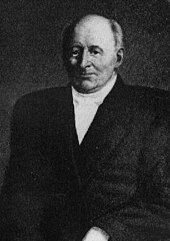| Solar cycle 7 | |
|---|---|
| Sunspot data | |
| Start date | May 1823 |
| End date | November 1833 |
| Duration (years) | 10.5 |
| Max count | 119.2 |
| Max count month | November 1829 |
| Min count | 0.2 |
| Cycle chronology | |
| Previous cycle | Solar cycle 6 (1810–1823) |
| Next cycle | Solar cycle 8 (1833–1843) |

Solar cycle 7 was the seventh solar cycle since 1755, when extensive recording of solar sunspot activity began.[2][3] The solar cycle lasted 10.5 years, beginning in May 1823 and ending in November 1833 (thus overlapping the Dalton Minimum). The maximum smoothed sunspot number observed during the solar cycle was 119.2 (November 1829), and the starting minimum was 0.2.[4]
See also[edit]
References[edit]
- ^ Excerpts from Solar Observations During 1843 by Heinrich Schwabe, (Astronomische Nachrichten, vol. 20., no. 495, 1843)
- ^ Kane, R.P. (2002), "Some Implications Using the Group Sunspot Number Reconstruction", Solar Physics, 205 (2): 383–401, Bibcode:2002SoPh..205..383K, doi:10.1023/A:1014296529097
- ^ "The Sun: Did You Say the Sun Has Spots?". Space Today Online. Retrieved 12 August 2010.
- ^ SIDC Monthly Smoothed Sunspot Number. "[1]"

Well, that’s interesting to know that Psilotum nudum are known as whisk ferns. Psilotum nudum is the commoner species of the two. While the P. flaccidum is a rare species and is found in the tropical islands. Both the species are usually epiphytic in habit and grow upon tree ferns. These species may also be terrestrial and grow in humus or in the crevices of the rocks.
View the detailed Guide of Psilotum nudum: Detailed Study Of Psilotum Nudum (Whisk Fern), Classification, Anatomy, Reproduction